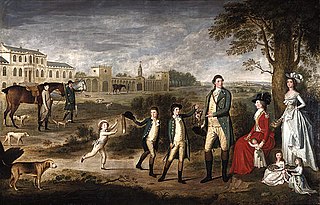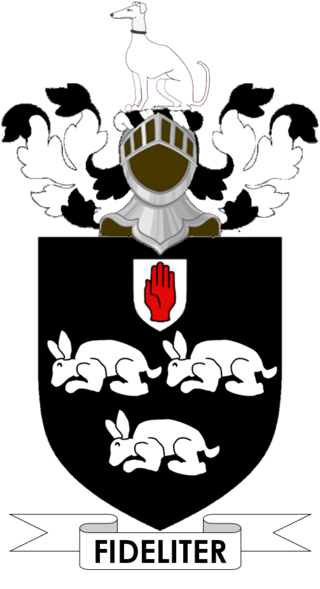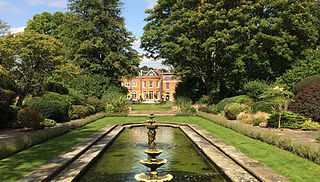
Earl St Aldwyn, of Coln St Aldwyn in the County of Gloucester, is a title in the Peerage of the United Kingdom. It was created in 1915 for the prominent Conservative politician Michael Hicks Beach, 1st Viscount St Aldwyn, known from 1854 to 1907 as Sir Michael Hicks Beach, 9th Baronet, of Beverston. He was Chancellor of the Exchequer from 1885 to 1886 and again from 1895 to 1902. Hicks Beach had already been created Viscount St Aldwyn, of Coln St Aldwyn in the County of Gloucester, in 1906, and was made Viscount Quenington, of Quenington in the County of Gloucester, at the same time he was given the earldom. Both titles are in the Peerage of the United Kingdom. He was succeeded by his grandson, the second Earl, the son of Michael Hicks Beach, Viscount Quenington, Member of Parliament for Tewkesbury, who was killed in action in 1916. Lord St Aldwyn was also a Conservative politician and was Captain of the Honourable Corps of Gentlemen-at-Arms between 1958 and 1964 and 1970 and 1974. As of 2018 the titles are held by his eldest son, the third Earl, who succeeded in 1992.

Baron Masham is a title that has been created three times, once in the Peerage of Great Britain and twice in the Peerage of the United Kingdom. It was first created in the Peerage of Great Britain in 1712 when the courtier Samuel Masham was made Baron Masham, of Otes. In 1723 he also succeeded as fourth Baronet of High Lever. The barony became extinct on the death of the second Baron in 1776. The Masham baronetcy, of High Lever in the County of Essex, was created by James I in the Baronetage of England on 20 December 1621 for Samuel Masham. The third Baronet was Member of Parliament for Essex. The baronetcy became extinct along with the barony in 1776.

There have been five baronetcies of the United Kingdom created for a person with the surname Erskine, two in the Baronetage of Nova Scotia, one in the Baronetage of Great Britain and two in the Baronetage of the United Kingdom. Two of the creations are extant as of 2010.
There have been two baronetcies created for people with the surname Jenkinson, both in the Baronetage of England. The seventh holder of the first creation was elevated to the peerage as Earl of Liverpool in 1796, a title which became extinct in 1851.

There have been four baronetcies created for persons with the surname Hope, three in the Baronetage of Nova Scotia and one in the Baronetage of the United Kingdom. As of 2010 one creation is extant, one dormant and two extinct.

There have been two baronetcies created for the Guise family, one in the Baronetage of England and one in the Baronetage of Great Britain. The latter creation is extant as of 2014.

There have been four baronetcies created for members of the Wills family, owners of W. D. & H. O. Wills and major shareholders and directors of the Imperial Tobacco Company. All four creations were in the Baronetage of the United Kingdom.
There have been two baronetcies created for persons with the surname Brooks, both in the Baronetage of the United Kingdom: one creation is extant as of 2007.
The Gwynne-Evans, later Evans-Tipping Baronetcy, of Oaklands Park in Awre in the County of Gloucester, is a title in the Baronetage of the United Kingdom. It was created on 17 June 1913 for William Gwynne-Evans. He received Royal licence to continue the use of the additional surname of Gwynne in 1913. The second Baronet served as high sheriff of Gloucestershire in 1943. The fourth Baronet assumed by deed poll the names of Francis Loring Gwynne Evans-Tipping in lieu of those of Francis Loring Gwynne-Evans in 1943 but resumed his patronymic of Gwynne-Evans by deed poll in 1958. The fifth Baronet used the surname Evans-Tipping. However, he did not use his title.
The Stott Baronetcy, of Stanton in the County of Gloucester, is a title in the Baronetage of the United Kingdom. It was created on 3 July 1920 for the architect, civil engineer and surveyor Philip Stott. The second Baronet was an architect and also served as high sheriff of Gloucestershire in 1947. The third Baronet was an architect and composer.
There have been two baronetcies created for persons with the surname Dunlop, with both in the Baronetage of the United Kingdom. One creation is extant as of 2007.

There have been two baronetcies created for members of the Codrington family, one in the Baronetage of Great Britain and one in the Baronetage of the United Kingdom. The family was for a long time connected with Dodington Park.
There have been four baronetcies created for persons with the surname Temple, two in the Baronetage of England, one in the Baronetage of Nova Scotia and one in the Baronetage of the United Kingdom.
There have been seven baronetcies created for persons with the surname Sinclair, six in the Baronetage of Nova Scotia and one in the Baronetage of Great Britain. Four of the creations are extant as of 2008.

The Cunliffe Baronetcy, of Liverpool in the County of Lancaster, is a title in the Baronetage of Great Britain. It was created on 26 March 1759 for Sir Ellis Cunliffe, a slave trader and Member of Parliament for Liverpool. The fourth Baronet was a General in the Bengal Army. The fifth Baronet represented Flint Boroughs and Denbigh Boroughs in the House of Commons.

The Beevor Baronetcy, of Hethel in the County of Norfolk, is a title in the Baronetage of Great Britain. It was created on 22 January 1784 for the prominent agriculturalist Thomas Beevor. The title has descended in the direct line from father to son.

The Royal Berkshire Hotel is a country house hotel within a noteworthy example of a late Queen Anne mansion previously called The Oaks and located at Ascot in the English county of Berkshire.
James Horlick may refer to:

Lieutenant-Colonel Sir James Nockells Horlick, 4th Baronet, OBE, MC (1886–1972) was the second son of Sir James Horlick, first holder of the Horlick Baronetcy, of Cowley Manor in the County of Gloucester, England, and Margaret Adelaide Burford. James, the 1st Baronet, was co-inventor of Horlicks Malted Milk drink.











